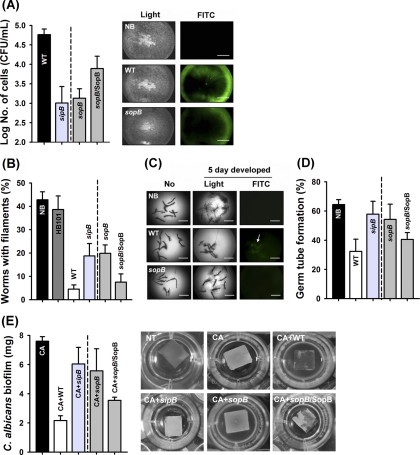Fig. 4.
S. Typhimurium strongly inhibits C. albicans filamentation and biofilm formation via the sopB effector. (A) Attachment of S. Typhimurium wild-type (WT) and sopB mutant strains to the C. albicans filaments. C. albicans SSY50-B filaments were formed in 96-well plates with 20 μg of DOX/ml and infected with GFP-expressing Salmonella strains for 15 h at 37°C. Salmonella attachment on C. albicans filaments was visualized by using fluorescence microscopy (scale bars, 1 mm) and counted by using the CFU assay. (B) Inhibition of C. albicans DAY185 filamentation in the C. elegans coinfection model. (C) Repression of filament elongation in the C. elegans coinfection model. An arrow indicates the GFP expression of S. Typhimurium cells on the C. albicans filaments (scale bars, 1 mm). (D) Inhibition of germ tube formation. (E) C. albicans biofilm formation on silicone squares in spider medium for 60 h at 37°C (NT, no treatment; CA, C. albicans alone; CA+WT, C. albicans cocultured with S. Typhimurium wild type; CA+sopB or sipB, C. albicans cocultured with the S. Typhimurium sopB or sipB mutants; CA+sopB/SopB, C. albicans cocultured with the S. Typhimurium sopB mutant overproducing SopB).

